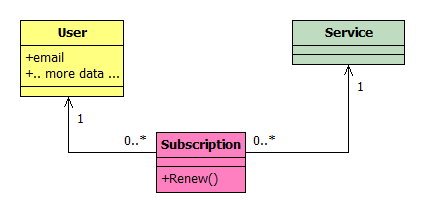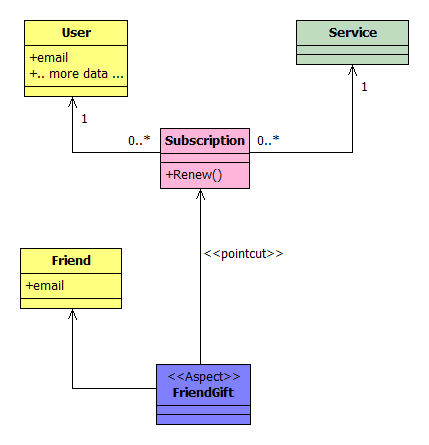This is not to say that nobody is thinking about the so-called early aspects. A notable work is the Theme Approach (there is also a good book about Theme). Please stay away from the depressing idea that use cases are aspects; as I said a long time ago, it's just too lame.
My personal view on early aspects is quite simple: right now, I mostly look for cross-cutting business rules as candidate aspects. I guess it's quite obvious that the whole "friend gift" concept is a business rule cutting through User and Subscription, and therefore a candidate aspect. Although I'm not saying that all early aspects are cross-cutting business rules (or vice-versa), so far this simple guideline has served me well in a number of cases.
It is interesting to see how early aspects tend to be cross-cutting (that is, they hook into more than one class) but not pervasive. An example of pervasive concern is the ubiquitous logging. Early aspects tend to cut through a few selected classes, and tend to be non-reusable (while a logging aspect can be made highly reusable).
This seems at odd with the idea that "AOP is not for singleton", but I've already expressed my doubt on the validity of this suggestion a long time ago. It seems to me that AOP is still in its infancy when it comes to good principles.
Which brings me to obliviousness. Obliviousness is an interesting concept, but just as it happened with inheritance in the early OOP days, people tend to get carried over.
Remember when white-box inheritance was applied without understanding (for instance) the fragile base class problem?
People may view inheritance as a way to "patch" a base class and change its behaviour in unexpected ways. But truth is, a base class must be designed to be extended, and extension can take place only through well-defined extensions hot-points. It is not a rare occurrence to refactor a base class to make extension safer.
Aspects are not really different. People may view aspects as a way to "patch" existing code and change its behaviour in unexpected ways. But truth is, when you move outside the safe realm of spectators (see my post above for more), your code needs to be designed for interception.
Consider, for instance, the initial idea of patching the User class through aspects, adding a data member, and adding a corresponding data into the database. Can your persistence logic be patched through an aspect? Well, it depends!
Existing AOP languages can't advise any given line: there is a fixed grammar for pointcuts, like method call, data member access, and so on. So if your persistence code was (trivially)
class Userthere would be no way to participate to the transaction from an aspect. You would have to refactor your code, e.g. by moving the SQL part in a separate method, taking the transaction as a parameter. Can we still call this obliviousness? That's highly debatable! I may not know the details of the advice, but I damn sure know I'm being advised, as I refactored my code to be pointcut-friendly.
{
void Save()
{
// open a transaction
// do your SQL stuff
// close the transaction
}
}
Is this really different from exposing a CreateSubscription event? Yeah, well, it's more code to write. But in many data-oriented applications, a well-administered dose of events in the CRUD methods can take you a long way toward a more flexible architecture.
A closing remark on the SOA part. SOA is still much of a buzzword, and many good [design] ideas are still in the decontextualized stage, where people are expected to blindly follow some rule without understanding the impact of what they're doing.
In my view, a crucial step toward SOA is modularity. Modularity has to take place at all levels, even (this will sound like an heresy to some) at the database level. Ideally (this is not a constraint to be forced, but a force to be considered) every service will own its own tables. No more huge SQL statements traversing every tidbit in the database.
Therefore, if you consider the "friend gift" as a separate service, it is only natural to avoid tangling the User class, the Subscription class, and the User table with information that just doesn't belong there. In a nutshell, separating a cross-cutting business rule into an aspect-like class will bring you to a more modular architecture, and modularity is one of the keys to true SOA.


